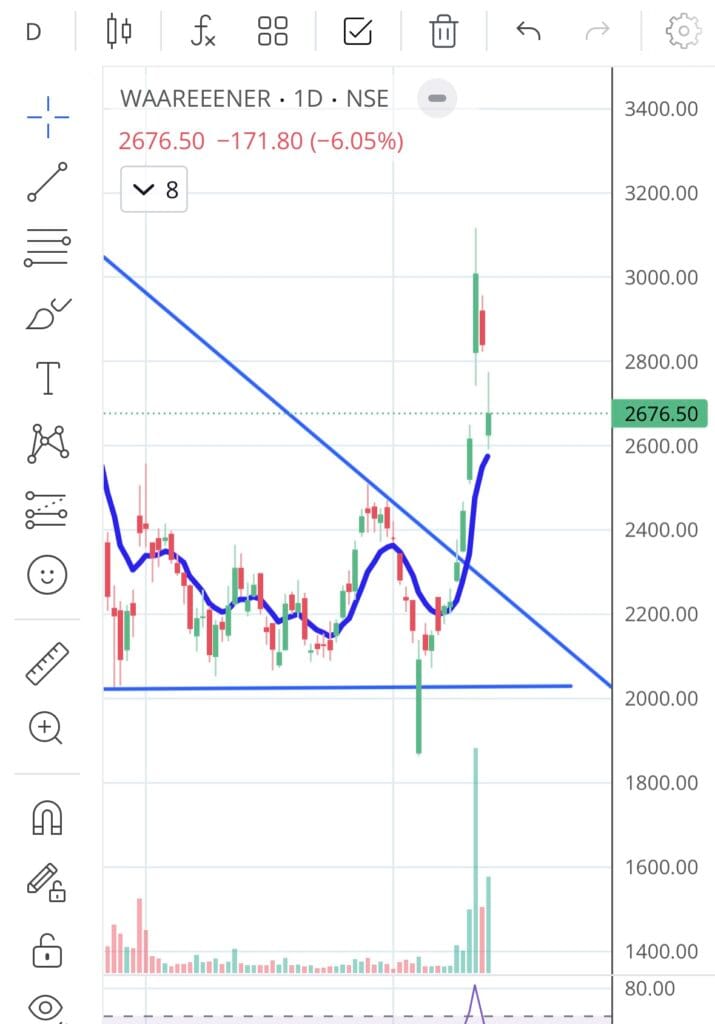In the world of technical analysis, breakout patterns often signal the beginning of a new trend. For Waaree Energies Ltd (NSE: WAAREENER), a company known for its solar equipment manufacturing, the recent price action is suggesting exactly that — but with a few important short-term developments that investors need to pay attention to.
Over the past several months, WAAREENER was locked in a steady downtrend. Each time the stock attempted to rally, it was pushed back by a strong descending trendline, indicating sustained selling pressure. However, in the past few sessions, the stock made a decisive move by breaking above this trendline with significant trading volumes, a textbook breakout signal that hints at a reversal of the long-standing bearish sentiment.

The breakout led to a sharp upward move, pushing the stock price to levels above ₹3000. However, Friday, April 25th, saw a sudden correction, with the stock closing lower at ₹2676.50, a 6% drop for the day. While at first glance this might appear to be a bearish sign, there’s more to the story than just price action.
Why Did Waaree Energies Fall on Friday?
The sharp fall on Friday was largely triggered by two external factors rather than a sudden change in the company’s fundamentals or technical setup.
First, Waaree Energies’ six-month lock-in period for shareholders expired on April 25th. This meant that approximately 15 crore shares, amounting to a staggering 53% of the company’s total outstanding equity, became eligible for trading. Naturally, with such a large quantity of shares entering the market, selling pressure was inevitable as early investors sought to book profits.
Secondly, global brokerage house Jefferies downgraded Waaree Energies to ‘Underperform’ with a reduced target price of ₹2100. This downgrade came after a 25% rally in the stock over the past month. Downgrades by reputed firms like Jefferies often create a sentiment shift, leading to short-term volatility as traders react to the news.
Hence, the fall on Friday appears to be more event-driven rather than a reversal of the bullish technical setup.
Technical Analysis: Structure and Key Levels
Looking purely at the chart, Waaree Energies’ breakout above the long-term descending trendline is very significant. Breakouts of this nature, especially when accompanied by strong volume spikes, typically mark the end of a corrective phase and the beginning of a new bullish cycle.
That said, after such strong moves, it’s normal and even healthy for stocks to retrace slightly before resuming their upward journey.
Support Levels:
- Immediate Support: ₹2500–₹2550 zone. This was the earlier resistance (the descending trendline) that has now flipped into support. If the stock can hold above this zone, the breakout will remain valid.
- Strong Support: ₹2000. This level acted as a major base throughout the past few months. Multiple times, the stock found buyers here, creating a strong demand zone.
Resistance Levels:
- Immediate Resistance: ₹3000–₹3100. This is where the stock faced selling pressure recently, leading to the current pullback.
- Major Resistance: ₹3400–₹3600. This zone corresponds to previous swing highs where the stock had reversed sharply during its downtrend.
Volume and RSI Analysis
The breakout was accompanied by a significant increase in trading volumes, confirming that institutional players and smart money might be getting involved. Volume confirmation is crucial to validate breakouts; without it, moves can often fail.
The Relative Strength Index (RSI), a momentum indicator, recently crossed above 70, entering the overbought territory. While an overbought RSI doesn’t necessarily mean an immediate sell-off, it often suggests that the stock may consolidate or retrace slightly before the next leg up. Interestingly, the RSI has cooled off a bit after Friday’s correction, which is a positive sign for the health of the overall uptrend.
Fundamental Context: Mixed Short-Term Sentiment
Fundamentally, the company remains strong, operating in a sector (renewable energy) that has significant long-term growth potential. However, the expiry of the lock-in period brought about an increase in supply that the market needed to absorb.
Brokerage downgrades like the one from Jefferies add another layer of short-term caution. When a stock has already seen a massive rally and then faces fresh supply and a downgrade, it’s natural for traders to book profits or re-evaluate positions.
Thus, while the breakout on technical charts remains strong, the fundamental news flow suggests that the stock may need some time to digest the recent supply pressure before resuming its upward journey.
Strategy for Investors and Traders
For short-term traders, the ₹2500–₹2550 zone becomes absolutely crucial. If this zone holds, the stock may consolidate for a few sessions and then attempt another breakout above ₹3100.
For positional investors, any dips closer to ₹2500 or even ₹2000 could be considered as buying opportunities for the medium-to-long term, given the strength of the sector and the technical breakout structure.
Risk Management Tip: If entering fresh trades now, keep a strict stop loss below ₹2500 on a daily closing basis. In case the stock fails to hold this zone, it could revisit ₹2000–₹2100, especially considering Jefferies’ target.
Conclusion
Waaree Energies has technically broken out of a long-term downtrend, and the overall structure remains bullish. However, due to the lock-in expiry and brokerage downgrade, short-term volatility could persist. Investors should stay patient and use dips for accumulation rather than chasing the price after sharp rallies.
Overall, the broader setup favors bullishness, but with cautious optimism for the next few weeks.
